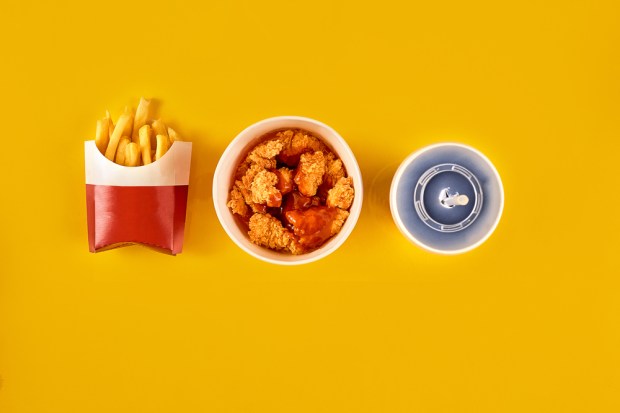Helping QSRs Avoid Physical Retail’s Fate

Once upon a time — about a decade ago — there was this QSR executive who observed the rise of online retail, but figured those changes would never apply to his businesses. He would never ship a hamburger, he thought. Nor would the basic processes of fast food change — people would still line up before a cashier, or take their place in the drive-thru, recite their order, pay and then take their food.
A simple business would remain simple, no matter how much eCommerce grew.
That executive was correct, except for the fact that so much has changed. Mobile payment and commerce apps, order-ahead technology, and food delivery services like Uber Eats and Grubhub have, indeed, led to the shipment of hamburgers, and the spread of other digital retail features throughout the world of QSR.
That story — told by Bypass Co-Founder and CEO Brandon Lloyd to Karen Webster during a recent PYMNTS interview — stands not only as an anecdote that demonstrates how much has changed in the QSR world, but also signals, in its way, how much hasn’t changed when it comes to quick-service restaurants.
Innovation is certainly playing an increasing role among QSRs, but the gaps between what consumers expect and what managers seem to want (and are comfortable with) are still significant. Just consider this finding from the recently published PYMNTS Restaurant Readiness Index: While 92 percent of customers find using an app to place a QSR order to be a positive experience, only 65 percent of QSR managers agree.
To Lloyd, such a finding calls up memories of how retail was 10 or 12 years ago, when physical stores didn’t often align with the operations of their online counterparts — returns of products bought online, for instance, were sometimes impossible to showcase inside physical stores — and when consumer expectations of digital retail outpaced store manager capabilities.
Similarly, QSR systems — ERP, supply chain, accounting and settlement — are now often “bifurcated,” Lloyd said, leading to “clunky” consumer experiences and transactions and an overall process that seems miles away from the ideal seamlessness that will no doubt become even more important in 2019. Sure, QSRs are adding what Lloyd called “bolt-on” technology to point-of-sale and other systems to meet consumer demand for the latest digital features, but such efforts are not all that seamless – and can lead to “downstream impacts for business, and not great ones,” he told Webster.
The gap shows up in other findings from the PYMNTS Restaurant Index. QSR apps are viewed favorably by nearly 92 percent of customers, while only 27 percent of QSR managers think positively of this ordering and payment method. Additionally, only 62.5 percent of QSR managers had confidence in QSR apps, in contrast to 90.9 percent of consumers in the context of payments.
“I am totally sympathetic with the restaurant manager and owner,” Lloyd said. “Everything has been built around taking orders via the cashier at the register, and that’s the way they’ve operated for the last 30-plus years.”
But now, to keep up with consumer demand for more digital options, and to be able to work with the different and expanding channels through which orders come in and products are delivered, a change is required in that longstanding process — a change that requires money, time and IT expertise, even for the smallest of QSR operators.
A lack of progress can create its own “self-fulfilling prophecy,” he said. “The first reaction is, ‘give me the simplest solution,’” he said of QSR operators looking to upgrade their digital game. But that simple solution might not play well with backend systems that identify where revenue is coming from, the impacts on the supply chain and other parts of the QSR operation. Then, “you’ve created a solution that’s an island” instead of a main part of the overall operation, he noted.
Getting away from that “island” mindset will require years of work — as was the case for retail in general, which, to be fair, is still figuring out the best ways to link physical and online stores, among other challenges. “It’s a new way of doing business for decades to come,” Lloyd said.
And QSRs face some unique challenges, too. Among them? Fraud. Sure, every payments and commerce sector must protect against criminals, but the difficultly for QSRs, in general, is that fast food is not often seen as a hotbed of fraud. But criminals — whether outsiders or insiders — can steal payment card and consumer ID data, and QSRs can still suffer from meaningful amounts of friendly fraud. As the QSR space becomes more digital, fraud opportunities are likely to increase.
Another challenge is that QSRs — like airlines and hotels — are a high fixed-cost business, Lloyd pointed out. But unlike airlines and hotels, QSRs tend to charge customers the same price for products.
There is a potential remedy for that: loyalty. According to the PYMNTS Restaurant Readiness Index, in fact, about 80 percent of both customers and QSR managers have positive views of loyalty programs. “Loyalty is a way to variably change your pricing,” Lloyd said, by using such factors as repeat customers and low- and high-traffic times of business to lure in new business via discounts and rewards.
The coming years will likely bring a narrowing of those gaps in the QSR world — after all, it’s not like the digital genie is going back in its bottle, or that mobile and online will be “treated as a separate business” as digital QSR becomes more mainstream, Lloyd said. But the work to reach that seamless ideal will be significant. After all, he said, QSR operators are “trying to put their business back together again” in response to digital demands.
